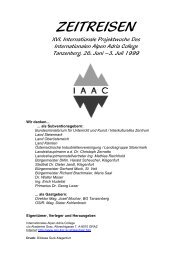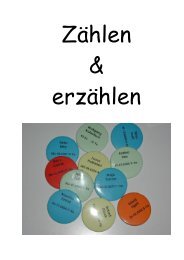Erfolgreiche ePaper selbst erstellen
Machen Sie aus Ihren PDF Publikationen ein blätterbares Flipbook mit unserer einzigartigen Google optimierten e-Paper Software.
Something about <strong>Chaos</strong> (physics group)<br />
What we have learned about chaos in our during the week<br />
At the beginning we thought, that chaos and order are two different things and that the word could be described<br />
by order. Now we are aware that ...<br />
Many people would define the chaos simply as a system where there is no order. But chaos is much more<br />
than no order because in every system even, if it doesn’t look so, you can find some rules. And this rules are<br />
the most important things in a system to find out because then you can see that every chaotic system is in<br />
reality no chaos but a very strangely ordered system which appears a little bit abnormal - unclear.<br />
So in general you can say that every system has its rules which define the look-like of the system, the macroscopic<br />
behaviour of the system. These rules could be different from system to system. So we could say<br />
that everything that exists on Earth is a system by itself and at the same time it is in contact with other system,<br />
influencing each other in some way. The systems consist of many subsystems influenced by force fields<br />
in which they are located - these can be outer fields or such fields which they create by self-organisation. In<br />
the system there can occur many random events.<br />
We think that some things are the same, but in reality you cannot say that some thing is exactly like an other<br />
because everything develops in a different direction and are in different conditions. So we can say that our<br />
whole Universe is a big order of nature but for us human beings it is confusing chaos.<br />
There is no chaos and order but one Nature. <strong>Chaos</strong> relates to us and we must try to keep realistic and practical<br />
and try to understand it as a wonderful unique miracle. Our challenge is to find our order. It relates to us<br />
to accept the chaos.<br />
The concepts of chaos and order are always related to a concrete system:<br />
PENDULUMS<br />
Considering about pendulums we usually think about simple mechanical<br />
systems. A mathematical pendulum is used as a classic<br />
example of regular periodic motion. Real pendulums do not act as<br />
mathematical pendulums. They either loose energy and stop in a<br />
certain time or they behave in chaotic way. A good example of chaotic<br />
motion is the magnetic pendulum. We could use it also as a<br />
model for complex chaotic systems of Nature (the beating of our<br />
heart, breathing, raining, lightning, population of animals, fluctuations<br />
of radio signals, and in the electric net, etc). The common features of<br />
these systems are:<br />
• DYNAMICS – the stage of the system is in development, it undergoes<br />
permanent changes until it is not interrupted or stopped.<br />
• UNSTABLE REGIONS - the chaotic system gets many times<br />
through unstable regions. These are the regions where the system must decide between different possibilities<br />
of its development.<br />
• INITIAL CONDITIONS – the chaotic system is strongly influenced by the initial conditions. We can never<br />
repeat them exactly in the same way. The system is always in different constellation, starting with different<br />
amount of energy etc.<br />
The conditions can be also influenced during the development!<br />
• ATTRACTORS – in spite of the differences of development the system is attracted to/or round significant<br />
stages.<br />
SAND<br />
Sand is an example of a SYSTEM OF MANY PARTICLES. This means that particles influence each other<br />
and all the particles together behave as one non-linear system. We cannot say what will happen with a certain<br />
grain of sand, we can only make predictions about some features of the system as a whole – about the<br />
main values of its characteristics. But the characteristics of each grain – their shapes, volumes, weights of<br />
course influence them.<br />
7





